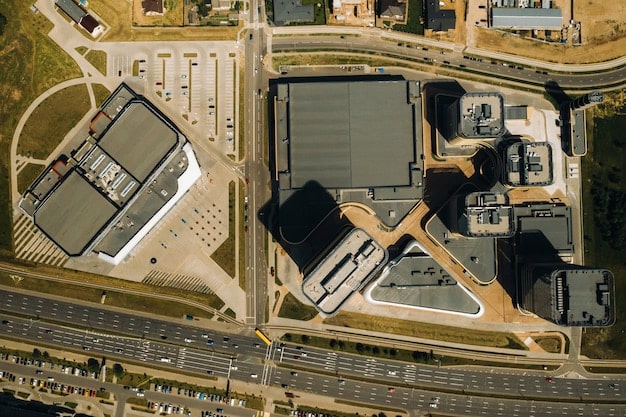US Battery Gigafactory Aims to Power 1 Million EVs Annually

A New US Battery Gigafactory aims to produce enough batteries annually to power 1 million electric vehicles, marking a significant step towards bolstering domestic electric vehicle battery production and reducing reliance on foreign suppliers.
The electric vehicle (EV) market is rapidly expanding, and with this growth comes an increased demand for EV batteries. The latest Electric Vehicle Battery Production News: New US Battery Gigafactory Aims to Produce Enough Batteries for 1 Million Electric Vehicles Annually signifies a major leap forward in meeting this demand and strengthening the domestic supply chain for EV components.
The Increasing Demand for EV Batteries in the US
The demand for electric vehicles (EVs) has been steadily increasing in the United States, driven by growing environmental awareness, government incentives, and advancements in EV technology. This surge in EV adoption has, in turn, created an unprecedented demand for EV batteries, the core component that powers these vehicles.
Factors Driving the EV Battery Demand
Several factors contribute to the growing demand for EV batteries. Government regulations aimed at reducing carbon emissions, such as the Inflation Reduction Act, provide substantial incentives for consumers to purchase EVs and for manufacturers to invest in battery production. Additionally, the declining cost of batteries and improvements in their energy density and charging times have made EVs a more attractive option for consumers.
The Current State of EV Battery Production
Currently, the EV battery supply chain is dominated by a few key players, primarily located in Asia. The United States is striving to reduce its reliance on foreign sources and establish a robust domestic battery production capacity to ensure a stable and secure supply of batteries for the burgeoning EV market.

The transition to electric vehicles is not just a trend; it’s a fundamental shift in how we approach transportation. The US is committed to leading the charge in this transformation, and boosting domestic battery production is a critical element.
- Government support and incentives are making EV batteries more affordable.
- Technological advancements are leading to more efficient batteries.
- Consumer demand for EVs is consistently increasing.
The future of the automotive industry is electric, and securing a reliable source of EV batteries is a top priority for the United States. The establishment of new gigafactories is a vital step in making this vision a reality.
Introducing the New US Battery Gigafactory
Amidst the increasing demand for EV batteries, a groundbreaking development emerges: a new US Battery Gigafactory. This state-of-the-art facility is poised to significantly impact the landscape of EV battery production in the United States.
Location and Scale of the Gigafactory
The gigafactory is strategically located in a region with access to key resources and infrastructure, facilitating efficient manufacturing and distribution. Its scale is impressive, designed to be one of the largest battery production facilities in North America.
Production Capacity and Goals
The primary goal of this gigafactory is to produce enough batteries annually to power 1 million electric vehicles. This ambitious target aligns with the growing demand for EVs and contributes to reducing the reliance on foreign battery suppliers.

The ripple effects of this gigafactory will be felt nationwide, from creating jobs to fostering technological innovation. It’s more than just a factory; it’s an engine for progress.
Technological Advancements and Innovation
Equipped with the latest technological advancements, the gigafactory is committed to producing high-performance, long-lasting EV batteries. This includes investments in advanced manufacturing processes, materials research, and battery management systems.
- Advanced automation systems to enhance production efficiency.
- Sustainable raw materials to minimize environmental impact.
- Stringent quality control measures to ensure battery reliability.
This gigafactory is not just keeping pace with technological progress but is actively driving it. It’s a testament to the innovation and dedication necessary to build a sustainable future.
Impact on the Electric Vehicle Market and Supply Chain
The introduction of the new US Battery Gigafactory will have a profound impact on the electric vehicle market and its supply chain. It represents a significant step towards greater self-sufficiency and reduced dependency on foreign suppliers.
Reducing Reliance on Foreign Suppliers
By increasing domestic battery production capacity, the gigafactory contributes to reducing the United States’ reliance on foreign battery suppliers. This ensures a more secure and stable supply chain for EV batteries, protecting the industry from potential disruptions and geopolitical uncertainties.
Strengthening the Domestic Supply Chain
The new gigafactory will also stimulate growth and investment in the domestic supply chain, creating opportunities for local businesses and suppliers. It fosters a vibrant ecosystem of battery component manufacturers, materials providers, and equipment suppliers.
A strong domestic supply chain creates jobs, boosts the economy, and ensures that the US remains competitive in the global EV market.
Job Creation and Economic Growth
The establishment of the gigafactory will lead to the creation of thousands of jobs, ranging from manufacturing and engineering to research and development. This influx of employment opportunities will boost local economies and contribute to overall economic growth.
- Direct job creation in the manufacturing sector.
- Indirect job creation in related industries.
- Increased economic activity in surrounding communities.
The economic benefits extend far beyond the factory walls, impacting families and communities throughout the region. This is how we build a sustainable future together.
Sustainability and Environmental Considerations
Sustainability is a core principle driving the development and operation of the new US Battery Gigafactory. The facility is committed to minimizing its environmental impact and promoting sustainable practices throughout its lifecycle.
Sustainable Manufacturing Practices
The gigafactory employs sustainable manufacturing practices to reduce energy consumption, minimize waste generation, and conserve water resources. This includes the use of renewable energy sources, closed-loop recycling systems, and advanced water treatment technologies.
Sourcing of Sustainable Raw Materials
The gigafactory prioritizes the sourcing of sustainable raw materials for battery production. This includes working with suppliers who adhere to responsible mining practices, promoting the use of recycled materials, and investing in research and development to find alternative, more sustainable materials.
Sustainable raw material sourcing is a cornerstone of responsible battery production, ensuring that environmental and social impacts are minimized.
Recycling and End-of-Life Management
The gigafactory is committed to responsible recycling and end-of-life management of EV batteries. This includes establishing partnerships with recycling companies to recover valuable materials from spent batteries and developing innovative technologies to extend battery lifespan and reduce waste.
- Battery recycling programs to recover valuable materials.
- Research and development of next-generation battery technologies.
- Collaboration with industry stakeholders to promote sustainable practices.
By embracing sustainable practices, the gigafactory aims to minimize its environmental footprint and contribute to a cleaner, more sustainable future for the EV industry.
Future Expansion and Technological Advancements
The new US Battery Gigafactory is not just a static operation; it’s a dynamic hub for innovation and continuous improvement. Future expansion plans and ongoing technological advancements are integral to its long-term success.
Plans for Increased Production Capacity
As the demand for EV batteries continues to grow, the gigafactory has plans to increase its production capacity through future expansions. This includes adding new production lines, expanding the facility footprint, and investing in advanced manufacturing equipment.
Development of Next-Generation Battery Technologies
The gigafactory is actively engaged in research and development to develop next-generation battery technologies. This includes exploring new battery chemistries, improving energy density and charging times, and enhancing battery safety and reliability.
Innovation in battery technology is critical to unlocking the full potential of electric vehicles and driving their mass adoption.
Collaboration with Research Institutions and Industry Partners
The gigafactory fosters collaboration with research institutions and industry partners to accelerate innovation and drive technological advancements. This includes sponsoring research projects, participating in joint development programs, and sharing knowledge and expertise.
- Partnerships with universities and research labs.
- Collaborative projects with industry leaders.
- Continuous improvement through data analysis and feedback.
By embracing collaboration and investing in innovation, the gigafactory is positioning itself to remain at the forefront of EV battery technology for years to come.
Challenges and Opportunities in EV Battery Production
While the new US Battery Gigafactory represents a significant milestone, there are challenges and opportunities that must be addressed to ensure the sustainable growth and success of EV battery production.
Addressing Supply Chain Bottlenecks
Supply chain bottlenecks, such as shortages of raw materials and components, can hinder battery production. Addressing these bottlenecks requires diversification of supply sources, investment in domestic production capabilities, and collaboration with suppliers to ensure a stable and reliable supply chain.
Ensuring Ethical and Sustainable Sourcing of Materials
Ensuring the ethical and sustainable sourcing of materials is crucial for maintaining the integrity of the EV battery industry. This includes implementing responsible mining practices, promoting the use of recycled materials, and investing in research and development to find alternative, more sustainable materials.
Ethical and sustainable sourcing is not just a best practice; it’s a moral imperative for the EV industry.
Overcoming Technological Hurdles
Overcoming technological hurdles, such as improving battery energy density, charging times, and safety, requires continuous investment in research and development. This includes exploring new battery chemistries, advancing battery management systems, and developing innovative manufacturing processes.
- Investing in advanced battery research and development.
- Promoting technological innovation through collaboration.
- Adopting industry best practices for quality and safety.
By addressing these challenges and capitalizing on emerging opportunities, the EV battery industry can pave the way for a cleaner, more sustainable transportation future.
The unveiling of this gigafactory is a testament to the evolving landscape of electric vehicle battery production. With a goal to power one million electric vehicles annually, the factory’s contribution cannot be understated.
| Key Point | Brief Description |
|---|---|
| 🏭 New Gigafactory | US-based plant aiming to produce batteries for 1 million EVs annually |
| 💲 Economic Impact | Job creation and reduced reliance on international supply chains |
| 🌱 Sustainability | Focus on sustainable manufacturing and ethical material sourcing |
| 🚀 Future Growth | Plans for expansion and development of next-gen battery tech |
Frequently Asked Questions
▼
The gigafactory aims to produce enough batteries annually to power 1 million electric vehicles, significantly boosting domestic EV battery supply.
▼
The gigafactory is expected to create thousands of jobs and stimulate growth in related industries, strengthening the US economy.
▼
The factory will utilize renewable energy, recycle materials, and source sustainable raw materials to minimize environmental impact.
▼
The factory will diversify supply sources and invest in domestic production to ensure a stable and reliable supply chain for batteries.
▼
The factory plans to increase production capacity and develop next-generation battery technologies to enhance EV performance and sustainability.
Conclusion
The new US Battery Gigafactory marks a significant advancement in the electric vehicle industry, representing a massive step towards sustainable transportation and energy independence for the United States. Its impact will be felt across the automotive landscape. By focusing on US Electric Vehicle Battery Production News: New US Battery Gigafactory Aims to Produce Enough Batteries for 1 Million Electric Vehicles Annually, the nation is well on its way towards a cleaner, more sustainable future.





